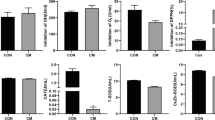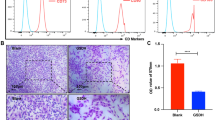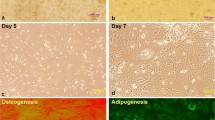Abstract
Human umbilical cord blood-derived stromal cells (hUCBDSCs) possess strong capability of supporting hematopoiesis and immune regulation, whereas some stress conditions cause reactive oxygen species (ROS) accumulation and then lead to oxidative injury and cell apoptosis. Ginsenoside Rg1 (G-Rg1) has been demonstrated to exert antioxidative and prosurvival effects in many cell types. In this study, the tert-Butyl hydroperoxide (t-BHP), an analog of hydroperoxide, was utilized to mimic the oxidative damage to hUCBDSCs. We aimed to investigate the effects of Ginsenoside Rg1 on protecting hUCBDSCs from t-BHP-induced oxidative injury and apoptosis, as well as the possible signaling pathway involved. It was shown that the treatment of hUCBDSCs with G-Rg1 markedly restored the t-BHP-induced cell viability loss, promoted the CFU-F formation, and inhibited cell apoptosis. G-Rg1 also caused a reduced production of LDH and MDA while significantly enhancing the activity of SOD. Mechanistically, G-Rg1 promoted the phosphorylation of Akt and FoxO3a and led to the cytoplasmic translocation of FoxO3a, which in turn suppressed FoxO3a-modulated expression of proapoptotic Bim and elevated the ratio of Bcl-2 to Bax. All these results suggest that G-Rg1 enhances the survival of t-BHP-induced hUCBDSCs and protects them against apoptosis at least partially through Akt–FoxO3a–Bim signaling pathway.










Similar content being viewed by others
Abbreviations
- HIM:
-
Hematopoietic inductive microenvironment
- HSCs:
-
Hematopoietic stem cells
- G-Rg1:
-
Ginsenoside Rg1
- t-BHP:
-
Tert-Butyl hydroperoxide
- hUCBDSCs:
-
Human umbilical cord blood-derived stromal cells
- BMSCs:
-
Bone marrow stromal cells
- ROS:
-
Reactive oxygen species
- PI3K:
-
Phosphoinositide-3-kinase
- Akt:
-
Protein kinase B (PKB/Akt)
- FoxO3a:
-
Forkhead box O3a
- MDA:
-
Malondialdehyde
- LDH:
-
Lactate dehydrogenase
- SOD:
-
Superoxide dismutase
- DMSO:
-
Dimethyl sulfoxide
- CCK-8:
-
Cell counting kit-8
- CFU-F:
-
Colony-forming unit of fibroblasts
- 7-AAD:
-
7-amino-actinomycin D
- TUNEL:
-
Terminal dUTP nick end labeling
- Br-dUTP:
-
Bromolated deoxyuridine triphosphate nucleotide
- TdT:
-
Terminal deoxynucleotidyl transferase
- PI:
-
Propidium iodide
- DAPI:
-
4′, 6′-diamidino-2-phenylindole
- PVDF:
-
Polyvinylidene difluoride
- c-caspase 3:
-
Cleaved-caspase 3
- Cyt c:
-
Cytochrome c
- Apaf-1:
-
Apoptosis protease activating factor-1
References
Anthony BA, Link DC (2014) Regulation of hematopoietic stem cells by bone marrow stromal cells. Trends Immunol 35:32–37
Mendelson A, Frenette PS (2014) Hematopoietic stem cell niche maintenance during homeostasis and regeneration. Nat Med 20:833–846
Pineault N, Abu-Khader A (2015) Advances in umbilical cord blood stem cell expansion and clinical translation. Exp Hematol 43:498–513
Gao L, Chen X, Zhang X, Liu Y, Kong P, Peng X, Liu L, Liu H, Zeng D (2006) Human umbilical cord blood-derived stromal cell, a new resource of feeder layer to expand human umbilical cord blood CD34 + cells in vitro. Blood Cells Mol Dis 36:322–328
Liu SS, Zhang C, Zhang X, Chen XH (2014) Human umbilical cord blood-derived stromal cells: a new source of stromal cells in hematopoietic stem cell transplantation. Crit Rev Oncol Hematol 90:93–98
Liu Y, Yi L, Zhang X, Gao L, Zhang C, Chen XH (2011) Cotransplantation of human umbilical cord blood-derived stromal cells enhances hematopoietic reconstitution and engraftment in irradiated BABL/c mice. Cancer Biol Ther 11:84–94
Gao L, Chen XH, Feng YM, Zhang X, Yu SC (2010) Human umbilical cord blood-derived stromal cells: multifaceted regulators of megakaryocytopoiesis. Cell Cycle 9:1342–1353
Zhang C, Chen XH, Zhang X, Gao L, Kong PY, Peng XG, Liang X, Gao L, Gong Y, Wang QY (2011) Human umbilical cord blood-derived stromal cells, a new resource in the suppression of acute graft-versus-host disease in haploidentical stem cell transplantation in sublethally irradiated mice. J Biol Chem 286:13723–13732
Alves H, Mentink A, Le B, van Blitterswijk CA, de Boer J (2013) Effect of antioxidant supplementation on the total yield, oxidative stress levels, and multipotency of bone marrow-derived human mesenchymal stromal cells. Tissue Eng Part A 19:928–937
Urao N, Ushio-Fukai M (2013) Redox regulation of stem/progenitor cells and bone marrow niche. Free Radic Biol Med 54:26–39
Ru W, Wang D, Xu Y, He X, Sun YE, Qian L, Zhou X, Qin Y (2015) Chemical constituents and bioactivities of Panax ginseng (C. A. Mey.). Drug Discov Ther 9:23–32
Li J, Wei Q, Zuo GW, **a J, You ZM, Li CL, Chen DL (2014) Ginsenoside Rg1 induces apoptosis through inhibition of the EpoR-mediated JAK2/STAT5 signalling pathway in the TF-1/Epo human leukemia cell line. Asian Pac J Cancer Prev 15:2453–2459
Gao Y, Chu S, Li J, Li J, Zhang Z, **a C, Heng Y, Zhang M, Hu J, Wei G, Li Y, Chen N (2015) Anti-inflammatory function of ginsenoside Rg1 on alcoholic hepatitis through glucocorticoid receptor related nuclear factor-kappa B pathway. J Ethnopharmacol 173:231–240
Cao L, Zou Y, Zhu J, Fan X, Li J (2013) Ginsenoside Rg1 attenuates concanavalin A-induced hepatitis in mice through inhibition of cytokine secretion and lymphocyte infiltration. Mol Cell Biochem 380:203–210
Tang YL, Zhou Y, Wang YP, Wang JW, Ding JC (2015) SIRT6/NF-κB signaling axis in ginsenoside Rg1-delayed hematopoietic stem/progenitor cell senescence. Int J Clin Exp Pathol 8:5591–5596
Lu XZ, Wang JH, Wu X, Zhou L, Wang L, Zhang XW (2008) Ginsenoside Rg1 promotes bone marrow stromal cells proliferation via the activation of the estrogen receptor-mediated signaling pathway1. Acta Pharmacol Sin 29:1209–1214
Jiang GZ, Li JC (2014) Protective effects of ginsenoside Rg1 against colistin sulfate-induced neurotoxicity in PC12 cells. Cell Mol Neurobiol 34:167–172
Mao N, Cheng Y, Shi XL, Wang L, Wen J, Zhang Q, Hu QD, FAN JM (2014) Ginsenoside Rg1 protects mouse podocytes from aldosterone-induced injury in vitro. Acta Pharmacol Sin 35:513–522
Zhang ZL, Fan Y, Liu ML (2012) Ginsenoside Rg1 inhibits autophagy in H9c2 cardiomyocytes exposed to hypoxia/reoxygenation. Mol Cell Biochem 365:243–250
Hu W, **g P, Wang L, Zhang Y, Yong J, Wang Y (2015) The positive effects of Ginsenoside Rg1 upon the hematopoietic microenvironment in a D-Galactose-induced aged rat model. BMC Complement Altern Med 15:119–126
Hu J, Gu Y, Fan W (2016) Rg1 protects rat bone marrow stem cells against hydrogen peroxide-induced cell apoptosis through the PI3K/Akt pathway. Mol Med Rep 14:406–412
Huang Y, Wu D, Fan W (2014) Protection of ginsenoside Rg1 on chondrocyte from IL-1β-induced mitochondria-activated apoptosis through PI3K/Akt signaling. Mol Cell Biochem 392:249–257
Leung KW, Yung KK, Mak NK, Chan YS, Fan TP, Wong RN (2007) Neuroprotective effects of ginsenoside-Rg1 in primary nigral neurons against rotenone toxicity. Neuropharmacology 52:827–835
Peng H, Du B, Jiang H, Gao J (2016) Over-expression of CHAF1A promotes cell proliferation and apoptosis resistance in glioblastoma cells via AKT/FOXO3a/Bim pathway. Biochem Biophys Res Commun 469:1111–1116
Sun HP, Zhang X, Chen XH, Zhang C, Gao L, Feng YM, Peng XG, Gao L (2012) Human umbilical cord blood-derived stromal cells are superior to human umbilical cord blood-derived mesenchymal stem cells in inducing myeloid lineage differentiation in vitro. Stem Cells Dev 21:1429–1440
Liu MH, Li GH, Peng LJ, Qu SL, Zhang Y, Peng J, Luo XY, Hu HJ, Ren Z, Liu Y, Tang H, Liu LS, Tang ZH, Jiang ZS (2016) PI3K/Akt/FoxO3a signaling mediates cardioprotection of FGF-2 against hydrogen peroxide-induced apoptosis in H9c2 cells. Mol Cell Biochem 414:57–66
Richardson C, Yan S, Vestal CG (2015) Oxidative stress, bone marrow failure, and genome instability in hematopoietic stem cells. Int J Mol Sci 16:2366–2385
Chang W, Song BW, Moon JY, Cha MJ, Ham O, Lee SY, Choi E, Hwang KC (2013) Anti-death strategies against oxidative stress in grafted mesenchymal stem cells. Histol Histopathol 28:1529–1536
Lu D, Zhu LH, Shu XM, Zhang CJ, Zhao JY, Qi RB, Wang HD, Lu DX (2015) Ginsenoside Rg1 relieves tert-Butyl hydroperoxide-induced cell impairment in mouse microglial BV2 cells. J Asian Nat Prod Res 17:930–945
Vidyashankar S, Mitra SK, Nandakumar KS (2010) Liv. 52 protects HepG2 cells from oxidative damage induced by tert-butyl hydroperoxide. Mol Cell Biochem 333:41–48
Fu JX, Shi XF, Qin JC, Ge Y, Zhang XG (2004) Homing efficiency and hematopoietic reconstitution of bone marrow-derived stroma cells expanded by recombinant human macrophage-colony stimulating factor in vitro. Exp Hematol 32:1204–1211
Marczak A, Denel-Bobrowska M, Rogalska A, Łukawska M, Oszczapowicz I (2015) Cytotoxicity and induction of apoptosis by formamidinodoxorubicins in comparison to doxorubicin in human ovarian adenocarcinoma cells. Environ Toxicol Pharmacol 39:369–383
Jomova K, Valko M (2011) Advances in metal-induced oxidative stress and human disease. Toxicology 283:65–87
Bresciani G, da Cruz I, González-Gallego J (2015) Manganese superoxide dismutase and oxidative stress modulation. Adv Clin Chem 68:87–130
Chen CY, Yi L, ** X, Mi MT, Zhang T, Ling WH, Yu B (2010) Delphinidin attenuates stress injury induced by oxidized low-density lipoprotein in human umbilical vein endothelial cells. Chem-Biol Interact 183:105–112
Ashour AE, Ahmed AF, Kumar A, Zoheir KM, Aboul-Soud MA, Ahmad SF, Attia SM, Abd-Allah AR, Cheryan VT, Rishi AK (2016) Thymoquinone inhibits growth of human medulloblastoma cells by inducing oxidative stress and caspase-dependent apoptosis while suppressing NF-κB signaling and IL-8 expression. Mol Cell Biochem 416:141–155
Peng CM, Ma JL, Gao X, Tian P, Li WZ, Zhang L (2013) High glucose induced oxidative stress and apoptosis in cardiac microvascular endothelial cells are regulated by FoxO3a. PLoS ONE 8:e79739
Mao Z, Zheng YL, Zhang YQ, Han BP, Chen LT, Li J, Li F, Shan Q (2008) Chronic application of nonylphenol-induced apoptosis via suppression of bcl-2 transcription and up-regulation of active caspase-3 in mouse brain. Neurosci Lett 439:147–152
Hu Y, Wang S, Wang A, Lin L, Chen M, Wang Y (2015) Antioxidant and hepatoprotective effect of Penthorum chinense Pursh extract against t-BHP-induced liver damage in L02 cells. Molecules 20:6443–6453
Sionov RV, Vlahopoulos SA, Granot Z (2015) Regulation of Bim in health and disease. Oncotarget 6:23058–23134
Faber AC, Ebi H, Costa C, Engelman JA (2012) Apoptosis in targeted therapy responses: the role of BIM. Adv Pharmacol 65:519–542
Chen MH, Chen SD, Lin DK (2016) Carvedilol protects bone marrow stem cells against hydrogen peroxide-induced cell death via PI3K-AKT pathway. Biomed Pharmacother 78:257–263
**a W, **e C, Jiang M, Hou M (2015) Improved survival of mesenchymal stem cells by macrophage migration inhibitory factor. Mol Cell Biochem 404:11–24
Shukla S, Rizvi F, Raisuddin S, Kakkar P (2014) FoxO proteins’ nuclear retention and BH3-only protein Bim induction evoke mitochondrial dysfunction-mediated apoptosis in berberine-treated HepG2 cells. Free Radic Biol Med 76:185–199
Liu MH, Yuan C, He J, Tan TP, Wu SJ, Fu HY, Liu J, Yu S, Chen YD, Le QF, Tian W, Hu HJ, Zhang Y, Lin XL (2015) Resveratrol protects PC12 cells from high glucose-induced neurotoxicity via PI3K/Akt/FoxO3a pathway. Cell Mol Neurobiol 35:513–522
Xu J, Qian J, **e X, Lin L, Zou Y, Fu M (2012) High density lipoprotein protects mesenchymal stem cells from oxidative stress-induced apoptosis via activation of the PI3K/Akt pathway and suppression of reactive oxygen species. Int J Mol Sci 13:17104–17120
Shi C, Zheng DD, Fang L, Wu F, Kwong WH, Xu J (2012) Ginsenoside Rg1 promotes nonamyloidgenic cleavage of APP via estrogen receptor signaling to MAPK/ERK and PI3K/Akt. Biochim Biophys Acta 1820:453–460
Zhu G, Wang Y, Li J, Wang J (2015) Chronic treatment with ginsenoside Rg1 promotes memory and hippocampal long-term potentiation in middle-aged mice. Neuroscience 292:81–89
Nho RS, Hergert P (2014) FoxO3a and disease progression. World J Biol Chem 5:346–354
Zhang S, Zhao Y, Xu M, Yu L, Zhao Y, Chen J, Yuan Y, Zheng Q, Niu X (2013) FoxO3a modulates hypoxia stress induced oxidative stress and apoptosis in cardiac microvascular endothelial Cells. PLoS ONE 8:e80342
Luo H, Yang Y, Duan J, Wu P, Jiang Q, Xu C (2013) PTEN-regulated AKT/FoxO3a/Bim signaling contributes to reactive oxygen species-mediated apoptosis in selenite-treated colorectal cancer cells. Cell Death Dis 4:e481
Acknowledgments
This work was financially supported by the National Natural Science Foundation of China (Grant number 30973818) and the National High-tech R&D Program of China (863 Program, Grant number 2014AA022302).
Author contributions
Liu Y. and Long Y. conceived and designed the experiments; Liu Y., Chen L.B., and Chen X.B. performed the experiments; Long Y. and Wang L. analyzed the data; Liu Y. prepared the manuscript; and Wang Y.P. supervised the whole research project.
Author information
Authors and Affiliations
Ethics declarations
Conflict of interest
The authors declare that they have no competing interests.
Rights and permissions
About this article
Cite this article
Liu, Y., Yi, L., Wang, L. et al. Ginsenoside Rg1 protects human umbilical cord blood-derived stromal cells against tert-Butyl hydroperoxide-induced apoptosis through Akt–FoxO3a–Bim signaling pathway. Mol Cell Biochem 421, 75–87 (2016). https://doi.org/10.1007/s11010-016-2786-y
Received:
Accepted:
Published:
Issue Date:
DOI: https://doi.org/10.1007/s11010-016-2786-y




